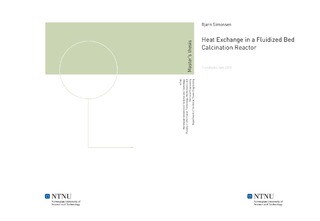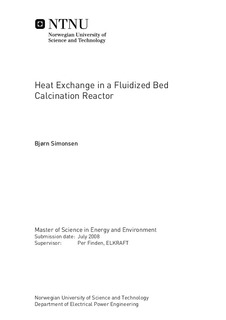| dc.description.abstract | Sorption Enhanced Steam Methane Reforming (SE-SMR) is a novel way of reforming natural gas to high purity hydrogen gas with in-situ CO2 capture by the introduction of a CO2 sorbent. The process is carried out in two steps. In the first step, hydrogen is produced and CO2 is absorbed by the sorbent. In the second step, the sorbent is exposed to high temperature heat and the CO2 is released. For the reforming to run continuously, two bubbling fluidized beds(BFB), can be coupled, one working as a reformer and the other one as a regenerator of the CO2 sorbent. The reformer works at a temperature around 500˚C and the regenerator at around 900˚C. Once the reactions in the reformer are being carried out the reformer works at a near autothermal state due to the exothermic reaction between CO2 and the sorbent. The regenerator however needs to be continuously supplied with heat to maintain at least 900˚C and for the endothermic calcination reaction of the sorbent to be carried out. One of the ways of providing heat to the process is by internal heat exchanger tubes. The advantage of using heat exchanger tubes is that no extra gas is added to the gas already in the bed (used interchangeably with reactor), thus not disturbing the volumetric flow and gas composition of the bed. For sequestration purposes, if the gases within the bed are not disturbed by for example nitrogen, N2, they will be easier to separate and sequester. An analytical calculation of the energy balance of a calcination reactor with horizontal heat transfer tubes was carried out, and the necessary effect was found to be 14.02kW, which equates to a heat exchanger with 96 tubes in 8 rows, taking up 26cm height in the reactor. Transferring heat via exhaust gas through metal tubes does however not yield a high thermal efficiency. One way of improving the efficiency of the calcinator is burning fuel gas directly in the reactor. This will lead to a direct heat exchange between the exhaust gas and the sorbent. On the other hand will the direct burning with air as an oxidizer lead to high fractions of N2 in the reactor. Considering that the gas in question in this work is biogas, the release of CO2 from the combustion is technically carbon neutral. Calculations for the necessary heat exchanger surface area and combustion rate of methane for the in-reactor combustion alternative have been carried out analytically, and a model of the in-reactor combustion has been established. At first, a fully fluidized bed model with integrated methane combustion was planned. Due to limitations of the modeling program and conversations with experts on the scope of the work in relation to the time-frame of the thesis, which is more closely discussed in Appendix H, the problem was reduced to a fixed bed approximation with black box combustion of methane outside the reactor. A heat balance, dependent on the rate of calcination was applied in the finite element modeling program COMSOL Multiphysics, and the resulting temperatures in the reactor were examined on the basis of what kind of fuel gas was used. In the first case, upgraded biogas, or SNG(Sustainable Natural Gas) was used as fuel gas. SNG is ~100% CH4, and the biogas has a CH4 content of ~48%. From the model it was seen that the mean temperature of the bed with SNG was 1218K, or 945˚C, and with the biogas the temperature of the bed was 1248K, or 975˚C. The calcination rate was found to be from 72.5 to 86.3% of the optimum. The lower results might be due to the adiabatic flame temperature of the gas and/or the relatively low heat capacity of the gas. | nb_NO |

